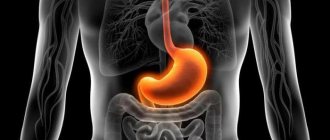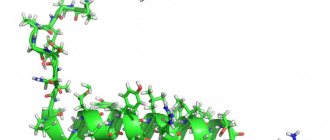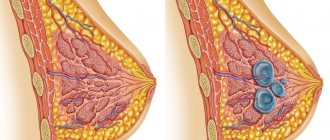Symptoms of adrenal gland dysfunction are very varied and can resemble different diseases, so it is very difficult to immediately make a correct diagnosis. The adrenal glands are responsible for many functions in the human body. They belong to the endocrine secretion glands and are located near the upper poles of the kidneys. Hence the name – adrenal glands.
The paired organ is responsible for the production of hormones in the body and also takes part in metabolic processes. Each gland weighs about 14 g. The right organ is in the shape of a pyramid, and the left one resembles a hemisphere. The adrenal glands have a very complex structure: 90% is the cortex, and the remaining 10% is the medulla.
General symptoms
Not a single person in the world is immune from possible health problems; accordingly, a malfunction of the adrenal glands can also easily occur. Any pathology of the endocrine glands does not act selectively. Both men and women can get sick, and even young children can have problems. In most cases, disturbances in the functioning of the paired organ occur due to the development of a certain pathology.
Diseases that affect the functioning of the adrenal glands and lead to certain symptoms will be described below. And now the general symptoms of adrenal pathologies will be described, these include:
- excessive pigmentation of the skin, or, conversely, its absence;
- in women, male-type hair growth (mustache, beard) may be visible, and the outline of the figure also changes;
- excess body weight or its sudden loss, despite the same diet;
- problem with the gastrointestinal tract.
Disturbances in the functioning of the adrenal glands affect all organs and systems.
Causes of problems in the functioning of the gland
The functions of the adrenal glands in the human body can be impaired for several reasons. This is primarily due to infectious diseases of the gland itself. The work of all systems and organs is negatively affected by the prolonged influence of stressful or depressive moods. Other reasons include:
- Administration of the hormone insulin
- Liver problems
- Birth injuries
- Autoimmune pathologies
- Tumor formation
- Pathologies of the vascular system
Primary adrenal insufficiency
Primary adrenal insufficiency is also known as Addison's disease. Pathology begins to develop after the gland tissue is destroyed. The age range ranges from 20 to 40 years.
Addison's disease occurs in people between 20 and 40 years of age
The signs of Addison's disease are as follows:
How to test adrenal function?
- depressive disorders, general weakness, increased fatigue;
- decreased appetite, followed by weight loss;
- under the influence of sunlight, the patient can get a burn or a severe tan;
- areas with sensitive skin acquire a more intense shade (lips, nipples, cheeks);
- development of ARVI;
- disorders of the genitourinary system;
- decreased blood pressure;
- nausea, followed by vomiting;
- constipation, upset stomach;
- In women, hair loss occurs on the pubis and armpits;
- menstrual irregularities;
- decreased libido.
Secondary adrenal insufficiency
Secondary adrenal insufficiency occurs due to disorders of the brain, which, in turn, develop due to pathologies of the hypothalamus or pituitary gland. For example: traumatic brain injuries of various origins, malignant and benign neoplasms. The symptoms of the disease are practically no different from primary adrenal insufficiency, but with secondary adrenal insufficiency there may be no pigmentation of the skin or it may not be clearly expressed.
Manifestations of hypothyroidism, hypogonadism and somatotropin deficiency (the hormone responsible for human growth) are also present.
Pheochromocytoma
Pheochromocytoma is a tumor that affects the adrenal medulla. In the presence of this pathology, the endocrine glands begin to synthesize dopamine, adrenaline and norepinephrine in excess. Signs of the disease include:
- unexpected increase in blood pressure;
- tachycardia;
- depressive disorders;
- headache;
- prostration;
- weight loss;
- emotional instability.
In the presence of pheochromocytoma, the adrenal medulla is affected
Organ structure
The adrenal glands consist of two layers – the cortex (90% of the organ’s mass) and the medulla. Each layer produces different hormones, which determines their nature and function.
The cortex consists of three zones:
- Glomerular - outside.
- Puchkova is in the middle.
- Mesh - inside.
Each zone produces different hormones. The main one is cholesterol .
The cortical part of the adrenal glands synthesizes mainly the corticosteroid group of hormones, which are divided into three subgroups - glucocorticoid, mineralocorticoid, and sex hormones.
The medullary zone releases adrenaline and norepinephrine.
Hyperaldosteronism
Hyperaldosteronism (Conn syndrome) occurs due to the development of the following diseases in the human body: heart failure, renal failure, cirrhosis. As a result, the activity of the adrenal glands is disrupted and they begin to synthesize aldosterone in large quantities. It is responsible for the total volume of blood, as well as its sodium and potassium content. Disturbances in the functioning of the cardiovascular system very often lead to the development of Conn's syndrome.
Symptoms of hyperaldosteronism include:
- increased blood pressure;
- prolonged headaches of severe intensity;
- constipation;
- swelling of tissues;
- convulsive episodes;
- short-term paralysis;
- rapid loss of performance;
- muscle weakness.
Vascular network and innervation
The coordinated work of the zones is ensured by unified blood circulation and nervous regulation. The blood supply to the adrenal glands is carried out by at least 30 vessels. The largest are the arteries of the same name:
- superior, extends from the diaphragmatic vessel;
- middle, originates from the abdominal aorta;
- lower, starts from the vessels of the kidneys.
Some arteries carry blood only to the cortex of the glands. Others pass through it and branch in the deep zone. Sinusoidal capillaries drain into the central venous vessel. On the right it merges with the inferior vena cava, and on the left it opens into the renal vena cava. The glands are rich in tiny vessels that carry blood to the base of the portal vein. Lymph from all tissues of the organ enters the lumbar nodes. The hypothalamic-pituitary structure and the autonomic department are responsible for regulation. The innervation system of the deep layer is sympathetic neurons.
Itsenko-Cushing's disease
With increased production of hormones by the adrenal glands, namely the cortex, as well as disturbances in the hypothalamic and pituitary regions, one can judge Itsenko-Cushing's disease. According to statistics, the disease most often occurs in women between 25 and 40 years of age.
Itsenko-Cushing syndrome is a disease that preferentially affects the female body
The main symptoms that indicate violations of the functional properties of the adrenal cortex are depressive disorders, sudden weight gain, in accordance with male characteristics, menstrual irregularities, circulatory disorders, and severe headaches. Male pattern hair growth, muscle weakness, osteoporosis, formation of a moon-shaped face, furunculosis develops, decreased libido, even with a light blow, a bruise immediately appears. At the first sign of a crisis, you must call an ambulance.
Types of adrenal dysfunction
The presented pathology can be congenital or acquired.
There are also two forms of it:
The acute form develops very quickly. Chronic – consistently, but is more difficult to treat and is accompanied by various complications.
Causes of acute form of adrenal dysfunction:
- Abrupt cessation of hormone intake.
- Purpura in the adrenal parenchyma.
- Stress caused by hormonal imbalance.
Symptoms include cramps, headaches, and decreased muscle tone. Further, depending on which system was affected, the following symptoms are distinguished:
- Nervous system – coma, lethargy, subcoma, low response.
- Cardiovascular system - pallor of the integument, weak pulse, constipation of the urinary system, cyanosis near the lips, hypotension.
- Gastrointestinal tract - spasms, vomiting, loose stools, bloating and flatulence, inability to take food.
It is impossible to cope with the manifestations on your own - they are strong and sharp. You should consult a doctor for diagnosis and treatment.
Causes of the chronic form of pathology:
- Gradually increasing nervousness and aggression.
- Chronic weakness, fatigue.
- Decreased mental abilities, memory, persistent migraine.
- In women, alopecia appears on the body.
- Decreased sexual desire.
- Excessive hyperhidrosis, urination at night.
- The need for food decreases, which leads to weight loss.
External manifestation is expressed in increased pigmentation of the entire body and even the mucous membrane.
Chronic adrenal dysfunction is of the following types:
- Primary – caused by infection in the parenchyma, manifested by an inflammatory process
- Secondary - manifests itself in hypofunction caused by changes in the tissues of the pituitary gland and hypothalamus.
Adrenal cortex dysfunction
The reason is heredity, the female sex most often suffers. They represent a failure in the secretion of various chemical compounds by the adrenal glands.
It manifests itself as acne, hair growth on the face and chest, disruption of the female cycle, difficulties with conception, and obesity.
With dysfunction of the adrenal cortex, other diseases may develop.
Addison's disease
This is a chronic disease of the adrenal glands caused by decreased production of hormones, mainly cortisol.
- Weakness, fatigue, depression, nausea.
- Poor appetite, weight loss.
- CFA disorder – diarrhea, loose stools, vomiting.
- Low blood pressure.
- Changes in psycho-emotional state - nervousness, aggression, irascibility, anxiety, tearfulness.
- Cramps, trimmer of head and arms.
- Dehydration of the body.
- Increased urination.
- Skin pigmentation disorder.
Hyperplasia of the adrenal cortex
A hereditary disease caused by improper synthesis of adrenal hormones. It is benign in nature, but can develop into a malignant tumor. With this disease, the production of cortisol is disrupted.
Cushing's syndrome
A rare disease found in women aged 25 to 40 years . It is associated with the production of corticosteroids by the adrenal glands.
Symptoms: sudden weight gain with thin limbs, depression, poor sleep, weakness, stretch marks appear on the face, menstrual irregularities, brittle bones.
Acute adrenal insufficiency
Acute adrenal insufficiency or Addisonian crisis has a number of characteristic symptoms, namely:
- a sudden loss of consciousness may occur, followed by the development of a coma;
- the number of trips to the toilet decreases;
- blood pressure drops significantly;
- diarrhea, which is accompanied by painful sensations in the abdomen.
If you have at least one symptom, you should immediately call an ambulance, and if you have the skills and opportunity, provide first aid.
Adrenal cyst
The cyst belongs to the category of benign neoplasms; its cavity is filled with fluid, does not have a clear localization, and therefore can be located in any part of the gland. The cyst does not pose a particular danger to the human body, as it belongs to the category of benign formations.
Typically, a cystic formation does not provoke certain symptoms, but if it begins to grow and increase in size, you may notice pain in the lower back, back and side, spasms of the gastrointestinal tract, and a feeling of squeezing; if the formation compresses the renal artery, then blood pressure increases , the normal functioning of the genitourinary system, including the kidneys, is disrupted.
Hormones
The adrenal cortex consists of three active layers that differ in structure and function: glomerular, fascicular and reticular.
About 30 different active substances are synthesized in the adrenal cortex.
Cortical hormones or corticosteroids are divided into three groups:
- Glucocorticoids (zona fasciculata hormones).
- Mineralocorticoids (hormones of the zona glomerulosa).
- Sex hormones (hormones of the reticular zone).
Glucocorticoid hormones are involved in the vital processes of protein, lipid and carbohydrate metabolism and have an anti-inflammatory effect.
Some glucocorticoids can stimulate fluid retention in tissues. This group includes cortisone, hydrocortisone, and corticosteroids.
The mineralocorticosteroid hormones aldosterone and dehydroxycorticosterone regulate water-salt metabolism and maintain normal kidney function.
During pregnancy, the level of progesterone in women's blood increases, which is necessary for normal gestation.
This is a temporary physiological norm; some time after childbirth or artificial termination of pregnancy, the concentration of progesterone decreases to its original level.
The medulla produces catecholamines, better known as stress hormones, norepinephrine and adrenaline. Catecholamines are involved in almost all regulatory processes involving the nervous system.
Tumor formations
Like any other organ, the adrenal glands can be susceptible to cancer, namely tumors. Among the oncopathologies of the endocrine glands there are: andosteroma, aldosterone, glucocorticosteroma and corticoestroma. The course of the disease can be either benign or malignant. There are two reasons for the development of the oncological process: the proliferation of cellular structures of the adrenal glands and their inflammation.
The tumor formation can significantly exceed the size of the adrenal gland
People with an adrenal tumor experience the following symptoms:
- the skin on the face becomes purple or pale, and the rest of the skin is blue;
- nausea turning into vomiting;
- blood pressure indicators increase;
- convulsive episodes;
- dryness of the oral mucosa;
- painful sensations behind the sternum and in the stomach;
- Blood glucose levels can either increase or decrease;
- increased excitability;
- tremor of the limbs.
Diagnosis of diseases
To make a correct diagnosis, an examination by a doctor is not enough; an integrated approach is of great importance. Diagnosis of diseases consists of the following examination methods:
- consultation with an endocrinologist;
- general and biochemical analysis of urine and blood;
- blood test for hormone levels.
For a more detailed examination, screening diagnostic methods are prescribed:
- Ultrasound;
- MRI;
- CT;
- puncture;
- radiography.
Adrenal Fatigue
Under the influence of prolonged stress or a severe stressful situation, depletion of the endocrine glands can occur. Unfortunately, such a disorder is not uncommon in the modern world, since a person is constantly in a hurry, running, experiencing nervous overstimulation at work, and in general, is under constant negative influence.
Adrenal exhaustion is characterized by: sudden changes in blood pressure, increased fatigue, and general weakness. Hair loss, problem skin, bleeding gums and dental diseases, pain in the knees and lower back, lightheadedness, tinnitus, and emotional instability appear.
Fatigue is one of the signs of adrenal exhaustion
You should carefully monitor your health and not get nervous about every little thing, since it is mood swings that affect the functioning of the adrenal glands. No one is immune from possible changes occurring in the body, so you should be careful about your own body. At the first unpleasant urge or painful sensations, you should definitely consult a doctor, as this will help avoid adverse consequences.











